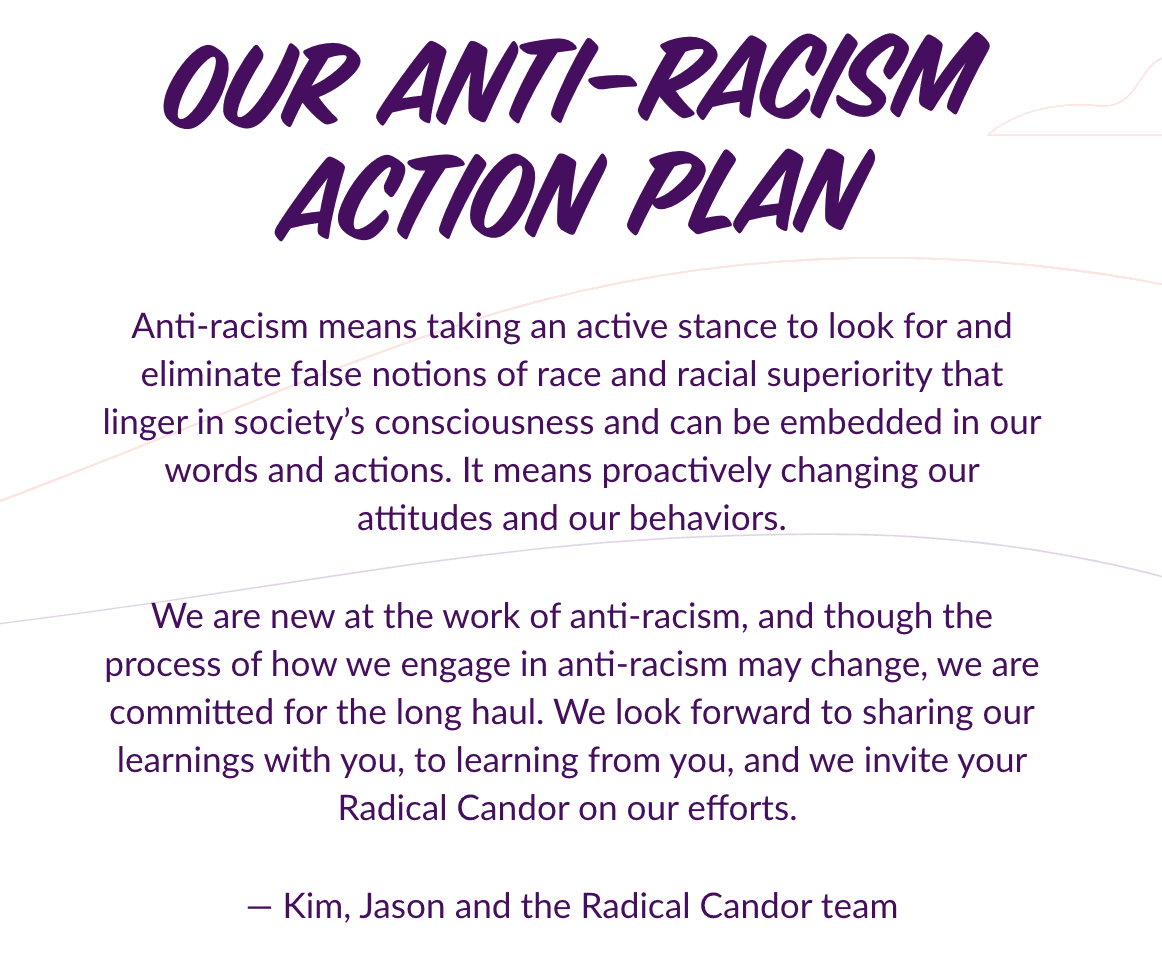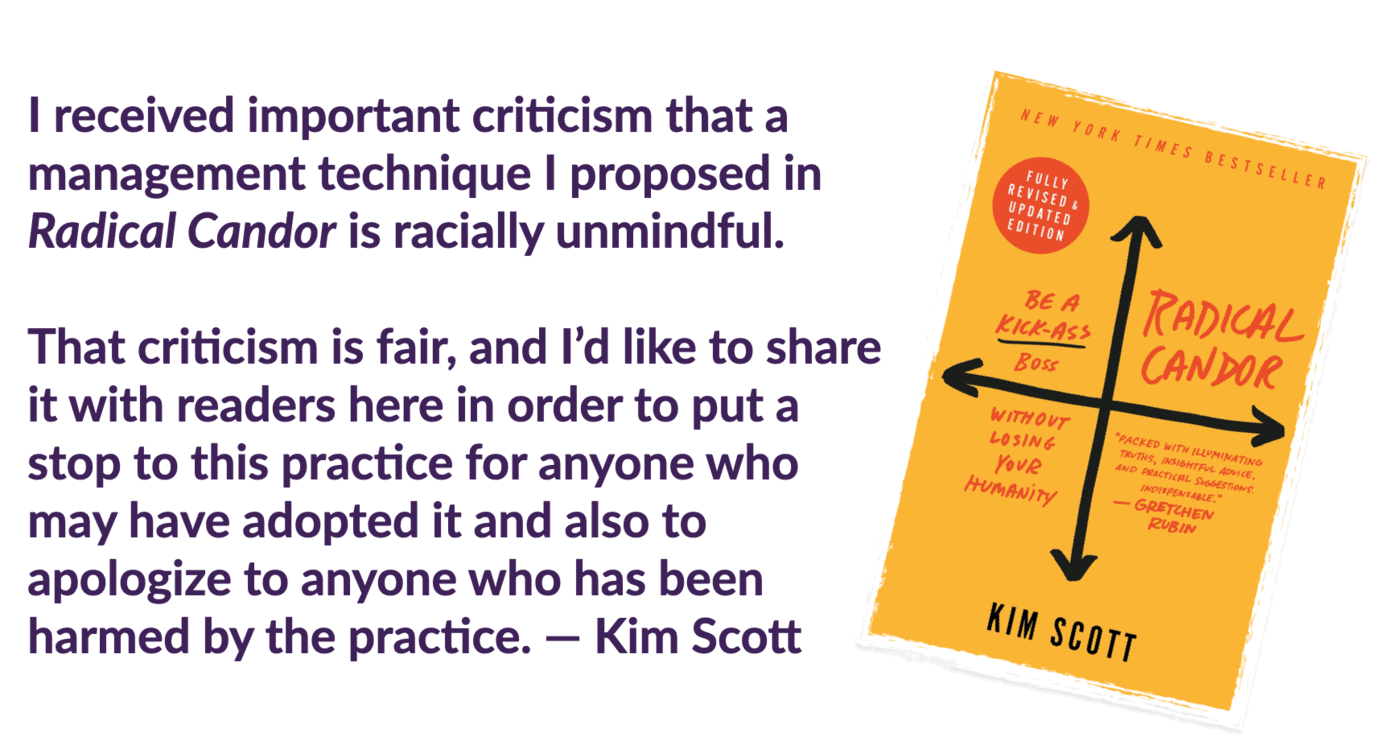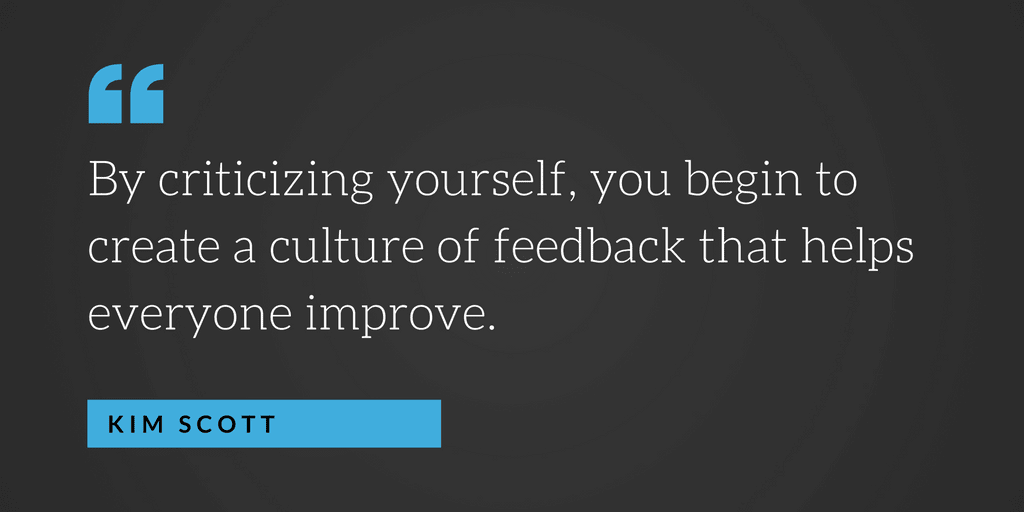I Received Some Important, Radically Candid, Criticism About My Own Implicit Racial Bias
Like many white people, I have been thinking about how I can best actively be engaged in the Black Lives Matter movement and dismantle systemic...
6 min read
Kim Scott Jun 16, 2020 1:44:42 PM

We have been compelled by recent, tragic events — including the murders of George Floyd, Breonna Taylor and Ahmaud Arbery, as well as the disproportionate toll of COVID-19 on Black, Indigenous and People of Color — to take a hard look at ourselves and ask, how has Radical Candor contributed to systemic racism and what specific steps will we take to be part of the solution?
For a company committed to helping everyone kick ass at work without losing their humanity, we are keenly aware that this will be an ongoing effort and involve a retooling of not only our company processes and practices, but also our products and services.
Our first reflection and action plan, shared here, focuses primarily on steps we are taking internally as individuals and as a company to become antiracist, as well as the broader historical context that provides a foundation for these decisions.
Future communications will focus on how we can interrupt racism and other forms of oppression and exclusion by applying an equity lens to the philosophy, teaching and practice of Radical Candor itself.
It is in the spirit of transparency and shared growth that we share with you the steps we are taking to create a more equitable version of Radical Candor, effective immediately.
Denial is the heartbeat of racism, beating across ideologies, races and nations. It is beating within us.” – Ibram X. Kendi
Antiracism means taking an active stance to look for and eliminate false notions of race and racial superiority that linger in society’s consciousness and can be embedded in our words and actions. It means proactively changing our attitudes and our behaviors.
We have hired Dr. A. Breeze Harper, an expert in inclusion and antiracism in the workplace, to start working with us to do the internal work that must be done. Becoming aware of one’s own denial is a tricky business.
We can do this work much more effectively with the help of Dr. Harper’s expertise and guidance. She can educate us about antiracism, but it will be up to us to replace our denial with a habit of anti-racist behavior.
This means being willing to interrupt one another’s biases in conversation, and to be really clear in the problems as we notice them, rather than to resort to euphemisms. In other words, to say, “I think that sounded racist,” rather than, “I don’t think you meant that how it sounded.”
A crucial part of this is how we receive such feedback. The temptation to respond defensively when it is pointed out that something we have done or said is racist is intense. That kind of defensiveness feeds denial and we must learn to be open to this feedback. The goal is to continuously implement antiracism as ongoing praxis (theory + action) so it becomes a habit in everything we do.
The essence of Radical Candor is challenging directly because you care about the person you work with, and have confidence in their ability to grow and improve.
And yet in the book Radical Candor, I (the Kim part of the we in the Radical Candor team) barely mentioned the attitudes, behaviors and power structures that lead to racism, sexism, homophobia, religious intolerance and economic injustice that so mar our workplaces and our world today.
My next book, Just Work: Get Sh*t Done, Fast & Fair, seeks to correct that. But writing another book to correct the mistakes of the previous book is not enough.
The temptation to respond defensively when it is pointed out that something we have done or said is racist is intense. That kind of defensiveness feeds denial and we must learn to be open to this feedback. The goal is to continuously implement antiracism as ongoing praxis (theory + action) so it becomes a habit in everything we do."
As Ibram X. Kendi wrote in How to be an Antiracist, "Denial is the heartbeat of racism, beating across ideologies, races and nations. It is beating within us.” We understand that if we truly want to be antiracist, we must be willing to challenge and to be challenged when we have done something that is racist.
And, in one instance in the book Radical Candor, I recommended a management technique that unintentionally could make most Black-identified employees feel excluded. Recently, I worked with an anti-racism-focused content editor to write a blog post that acknowledged this mistake.
To make sure we minimize the chance that we repeat similar racially unmindful mistakes, we will continue to work with Dr. Harper to help us learn to flag racially unmindful or even racist content, and to identify other exclusive language (e.g., sexism, ableism, homophobia, transphobia, religious intolerance, etc). This will be the standard protocol before we publish.
We are committed to adjusting our hiring process until our organization reflects the diversity of people we know are passionate about Radical Candor. We also know that diverse teams on which everyone contributes and feels psychologically safe outperform homogeneous teams. Right now, even with just four full-time team members, we are too homogeneous.
If we don’t address this as we grow, it will impede our success as surely as it deprives others of opportunity. Going forward, we will treat homogeneity in our team as what it is: a sign that we’re missing critical perspectives and experiences that we need to succeed.
Like many tiny startups, we came together through personal networks, which reflected the structural injustice of our society. Though not intentional, we hired in an exclusive and unfair way because it was easier and more comfortable. Moving forward, we will define inclusive and equitable hiring practices centered on antiracism, as well as other practices that promote heterogeneity of talent.
We are creating with our team and Candor Coaches a Code of Conduct and a Shared Values statement. The Code of Conduct outlines what we expect from ourselves, each other and the standards we will hold each other to based on these values.
Anyone who is part of the current Radical Candor team will be expected to share this commitment to an antiracist and overall inclusive mindset. Onboarding of new hires and Coaches will be contingent upon their shared commitment to our anti-racist (as well as anti-sexist, anti-homophobic, anti-ableist, etc.) values. We will publish these statements when they are finished, and we will continue to iterate upon them as required.
When hiring any new person, or partnering with any company, we will make sure to do proactive reference checks to learn if the person we are hiring or company we are working with has a history of racism (as well as other problematic behavior entrenched in prejudice, such as sexism or homophobia).
Wherever we hire a new person, we do “backdoor” reference checks. We ask about all sorts of things in these reference checks, but we have not asked questions like, “Would you describe this person as antiracist?” The Shared Values Statement and Code of Conduct will play an important role in proactive reference checks going forward.
To hold ourselves accountable for living up to these commitments and continually improve in our commitment to racial justice, we will hire a firm like Paradigm, Kaleidoscope Group, or CultureAmp to audit the result of our DEI progress.
If we can hire an accountant to audit our books, we can hire an outside firm to help keep us accountable on these matters, which are leading indicators of our success; our financials are merely lagging indicators.
The institution of antebellum slavery in the U.S. was a moral crime. In order to justify this crime, certain Europeans with light skin color invented a false construct called “race,” and based it on phenotypes (i.e., observable characteristics), pseudo-science and strategic misinterpretations of the Bible. This racial caste system “rationalized” why “the white race” was supposedly superior.
Even though most people like to think we have eliminated these false notions of white superiority (these notions that underlie white supremacy), these ideas infect the thinking of the majority of people, well into today. This is a problem not only among the blatantly evil racist institutions like the KKK.
It is also a problem for white liberals, of which I (Kim) am one, because we are most apt to deny their existence. We can’t fix what we refuse to notice. Being antiracist means being willing to end this denial, to call out our own racism, with the intent of changing it, and with the knowledge that we can only change it if we challenge it directly, call it out by name.
These actions, like any words we can utter, are only a beginning. We will hold ourselves accountable by reviewing these quarterly, keeping an updated report of what we have done, what we have learned and the impact it has had. The problem of injustice is one that must be managed, hourly, daily.
It does not get “solved” in a check-the-box-we-are-done-and-don’t-have-to-think-about-this-again way. Much of this work is work that will never be finished.
We are new at the work of antiracism, and though the process of how we engage in antiracism may change, we are committed for the long haul. We look forward to sharing our learnings with you, to learning from you, and invite your Radical Candor on this.
In solidarity,
Kim, Jason and the Radical Candor team
P.S. While what will matter most will be our day-to-day actions, here’s some of what we as a team are currently reading, watching and listening to:
READ: How to be an Antiracist, Ibram X. Kendi
WATCH: Uprooting White Fragility, Dr. A. Breeze Harper
TOOLKITS: Me and White Supremacy, Layla Saad; 135 Racial Equity Resources; Becoming Anti-Racist Resource List
TRAINING: Becoming an Anti-Racist Leader: Strategies and Action Steps for a More Inclusive Workplace with A. Breeze Harper + Keegan Walden
RELATED: #StopAsianHate — 5 Ways To Be an Upstander Instead of a Bystander

Like many white people, I have been thinking about how I can best actively be engaged in the Black Lives Matter movement and dismantle systemic...

Shortly after she published Radical Candor, Kim Scott realized that biased feedback and protective hesitation make giving and receiving guidance more...

Two of my goals in starting Candor, Inc. and also in writing Radical Candor are to help others learn from my mistakes, and to encourage leaders to be...